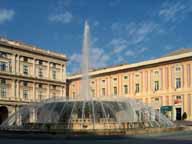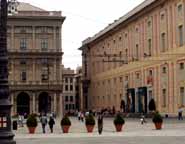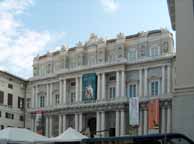This passage from Pictures from Italy, which has been scanned and edited by Philip V. Allingham, appears on pp. 36-39 of the edition published in Americas by Collier; see bibliography below.]

The Strada Nuova, Genoa. [Click on the thumbnail for a larger image.]
When shall I forget the Streets of Palaces: the Strada Nuova and the Strada Baldi! or how the former looked one summer day, when I first saw it underneath the brightest and most intensely blue of summer skies: which its narrow perspective of immense mansions, reduced to a tapering and most precious strip of brightness, looking down upon the heavy shade below! A brightness not too common, even in July and August, to be well esteemed: for, if the Truth must out, there were not eight blue skies in as many midsummer weeks, saving, sometimes, early in the morning; when, looking out to sea, the water and the firmament were one world of deep and brilliant blue. At [36/37] other times, there were clouds and haze enough to make an Englishman grumble in his own climate.
The endless details of these rich Palaces: the walls of some of them, within, alive with masterpieces by Van dyke! The great, heavy, stone balconies, one above an other, and tier over tier; with here and there, one larger than the rest, towering high up—a huge marble platform; the doorless vestibules, massively barred lower windows, immense public staircases, thick marble pillars, strong dungeon-like arches, and dreary, dreaming, echoing vaulted chambers: among which the eye wanders again, and again, arid again, as every palace is succeeded by another—the terrace gardens between house and house, with green arches of the vine, and groves of orange-trees, and blushing oleander in full bloom, twenty, thirty, forty feet above the street—the painted halls, mouldering, and blot ting, and rotting in the damp corners, and still shining out in beautiful colours and voluptuous designs, where the walls are dry—the faded figures on the outsides of the houses, holding wreaths, and crowns, and flying upward, and downward, and standing in niches, and here and there looking fainter and more feeble than elsewhere, by contrast with some fresh little Cupids, who on a more recently decorated portion of the front, are stretching out what seems to be the semblance of a blanket, but is, indeed, a sun-dial—the steep, steep, up-hill streets of small palaces (but very large palaces for all that), with marble terraces looking down into close by-ways�the magnificent and innumerable Churches; and the rapid passage from a street of stately edifices, into a maze of the vilest squalor, steaming with unwholesome stenches, and swarming with half-naked children and whole worlds of dirty people—make up, altogether, such a scene of wonder: so lively, and yet so dead: so noisy, and yet so quiet: so obtrusive, and yet so shy and lowering: so wide awake, and yet so fast asleep: that it is a sort of intoxication to a stranger to walk on, and on, and on, and look about him. A bewildering phantasmagoria, with all the inconsistency of a dream, and all the pain and all the pleasure of an extravagant reality![37/38]



Geneose palazzi. [Click on the thumbnails for larger images.]
The different uses to which some of these Palaces are applied, all at once, is characteristic. For instance, the English Banker (my excellent and, hospitable friend) has his office in a good-sized Palazzo in the Strada Nuova. In the hall (every inch of which is elaborately painted, but which is as dirty as a police-station in London), a hook-nosed Saracen's Head with an immense quantity of black hair (there is a man attached to it) sells walking-sticks. On the other side of the doorway, a lady with a showy handkerchief for head-dress (wife to the Saracen�s Head, I believe) sells articles of her own knitting and some times flowers. A little further in, two or three blind men occasionally beg. Sometimes, they are visited by a man without legs, on a little go-cart, but who has such a fresh-coloured, lively face, and such a respectable, well-conditioned body, that he looks as if be bad sunk into the ground up to his middle, or had come, but partially, up a flight of cellar-steps to speak to somebody. A little further in, a few men, perhaps, lie asleep in the middle of the day; or they may be chairmen waiting for their absent freight. If so, they have brought their chairs in with them, and there the stand also. On the left of the hail is a little room: a hatter's shop. On the first floor, is the English bank. On the first floor also, is a whole house, and a good large residence too. Heaven knows what there may he above that; but when you are there, you have only just begun to go up stairs. And yet, coming down stairs again, thinking of this; and passing out at a great crazy door in the back of the hail, instead of turning the other way, to get into the street again; it bangs behind you, making the dismallest and most lonesome echoes, and you stand in a yard (the yard of the same house) which seems to have been unvisited by human foot, for a hundred years. Not a sound disturbs its repose. Not a head, thrust out of any of the grim, dark, jealous windows, within sight, makes the weeds in the cracked pavement faint of heart, by suggesting the possibility of there being hands to grub them up. Opposite to you, is a giant figure carved in stone, reclining, with an urn, upon a lofty piece of artificial [38/39] rockwork; and out of the urn, dangles the fag end of a leaden pipe, which, once upon a time, poured a small torrent down the rocks. But the eye-sockets of the giant are not drier than this channel is now. He seems to have given his urn, which is nearly upside down, a final tilt; and after crying, like a sepulchral child, "All gone!" to have lapsed into a stony silence.
Related Material
- Palazzo Peschiere and Genoa — a Gallery of Places Dickens lived or visited
- Dickens and Family at the Villa di Bella Vista (The Bagnerello), Albaro: July-September, 1844
- Dickens describes the Bagnerello in Pictures from Italy
References
Dickens, Charles. American Notes & Pictures from Italy. New York: P. F. Collier & Son, n. d. [Originally published in London by Bradbury & Evans in May 1846).
Last modified 23 February 2024